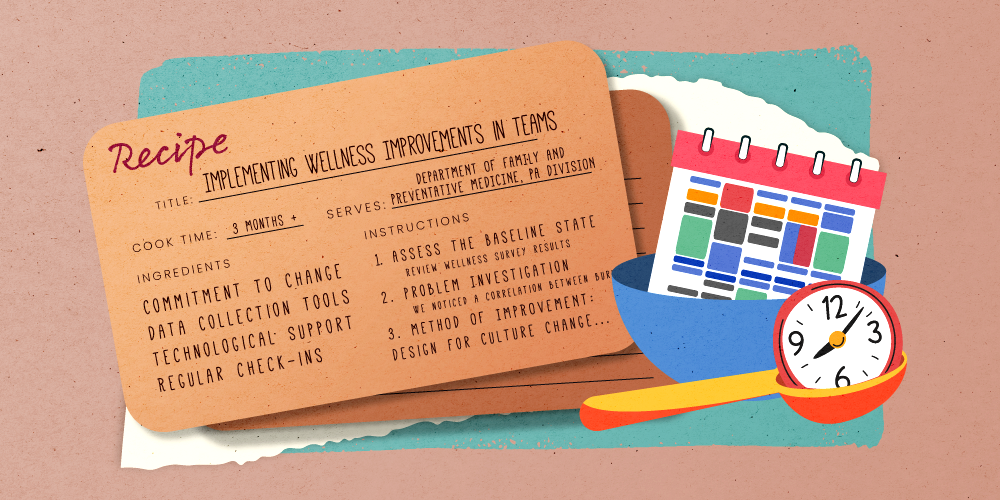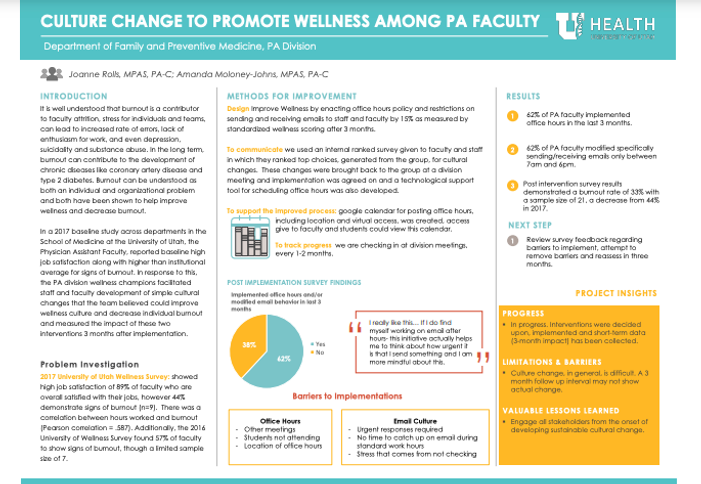professional environments, burnout poses a significant threat to individual well-being and team effectiveness. Within the School of Medicine at the University of Utah, concerns arose over high levels of burnout among Physician Assistant (PA) Faculty despite reported high job satisfaction. To address this issue, wellness champions within the PA division-initiated efforts to enhance team well-being and reduce burnout symptoms.
Through a wellness survey, it was revealed that while 89% of PA Faculty reported high job satisfaction, 44% exhibited signs of burnout. A correlation between hours worked and burnout was observed, prompting the need for intervention.
The PA division wellness champions facilitated the development and implementation of simple cultural changes aimed at improving team well-being.
This included enacting office hours policies and email restrictions, supported by the use of technological tools like a Google calendar for scheduling office hours and culture changes on sending and receiving emails to staff and faculty.
Three months post-implementation, the impact of these interventions was measured. Post-intervention survey findings indicated a significant decrease in burnout rates, with 62% of PA Faculty reporting the implementation of office hours and email behavior modifications, leading to a decrease in burnout from 44% to 33% within the sample size of 21.
The following recipe distills the successful strategies employed by the PA division into actionable steps for other teams seeking to enhance wellness and reduce burnout within their organizations.
Recipe for Implementing Wellness Improvements in Teams
Ingredients:
- Commitment to Change: Ensure team members are dedicated to enhancing wellness culture and decreasing burnout.
- Data Collection Tools: Utilize surveys and standardized wellness scoring to gauge burnout levels.
- We used a wellness survey administered by the School of Medicine.
- Communication Channels: Establish effective communication channels for soliciting feedback and disseminating cultural change proposals.
- Technological Support: Use technological tools to support the implementation of wellness interventions.
- Regular Check-ins: Schedule regular meetings to track progress and address any barriers to implementation.
Instructions:
Review wellness survey results to understand the current state of job satisfaction and signs of burnout among team members.
- Analyze survey results to identify correlations.
- We noticed a correlation between burnout and hours worked
- Generate possible changes that could enhance wellness.
- The PA Wellness Champions generated a list of potential cultural changes.
Design for Culture Change
- Solicit feedback from team members to pinpoint cultural changes that could enhance wellness.
- We generated a list of possible culture changes and sent a ranked survey to faculty to determine their top priorities.
- Determine implementation steps and measurement tools.
- At a division meeting we agreed to enact an office hours policy and restrictions on sending emails to faculty and staff.
- We determined technological support could increase the likelihood of success.
- We decided to use check-ins to monitor progress and a survey to assess impact.
- Roll out cultural changes and use of technological support tools.
- We enacted an office hours policy and restrictions on sending and receiving emails to staff and faculty.
- We used tools such as Google calendar for posting office hours, location, and virtual access.
- Provide training and support to ensure successful adoption.
- Access to the technology tools was provided to all faculty, staff and students.
- Schedule and perform regular monitoring of implementation and progress.
- We checked in at division meetings every 1-2 months.
- Collect feedback through post-implementation surveys to measure the impact of interventions on wellness.
- We sent a survey after 3 months of implementation.
- Review post-intervention survey findings to gauge changes in burnout rates.
- Burnout rates decreased from 44% to 33%
- Identify any limitations or barriers to implementation and develop any necessary modifications.
- Celebrate successes and acknowledge improvements in wellness culture.
- 62% of faculty implemented the intervention!
- Review feedback regarding barriers to implementation and adjust strategies to ensure sustained progress.
Serving Instructions:
- Share project insights and lessons learned with all stakeholders.
- Continuously engage team members in developing sustainable cultural change.
Notes for Successful Implementation:
- Recognize that culture change takes time and effort.
- Be open to feedback and adapt strategies as needed to address evolving challenges.
- Engage all stakeholders from the onset to ensure buy-in and commitment to change.
This program is supported by the Health Resources and Services Administration (HRSA) of the U.S. Department of Health and Human Services (HHS). The contents are those of the author(s) and do not necessarily represent the official views of, nor an endorsement, by HRSA, HHS, or the U.S. Government. For more information, please visit HRSA.gov.
Joanne Rolls
Amanda Moloney-Johns
Nurse educators often find themselves navigating a landscape filled with burnout risks. Seeking solutions, Cassidy Kotobalavu, Amanda Keddington, and Mary-Jean Austria devised a method for improvement, distilling their success into a recipe for fostering team well-being amidst adversity.
It might seem basic, but just calling someone by their name is one of the most powerful forms of recognition a physician can give their team. Moran Vision Services administrative director Brent Price and physician and vice chair Norm Zabriskie share the many lessons they learned from putting employees’ voices at the center of resilience efforts.
With the month of Ramadan quickly approaching for our Muslim patients, many will want to keep up with their dental routines, so that fasting doesn’t have a negative impact on their oral health. University of Utah School of Dentistry's Arman Farhadtouski and Marcy Rogers empower their fellow providers with tips for Ramadan-friendly dental care.

